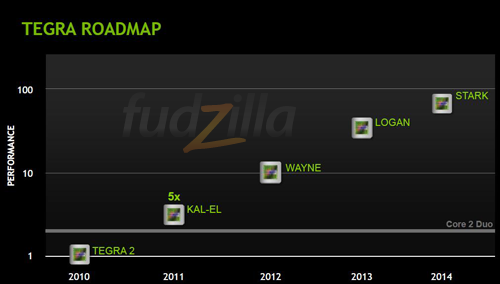Nvidia has just showcased its Tegra 3 codenamed Kal-El and claims that this quad core 28nm part is five times faster than Tegra 2 and even slightly faster than a Core 2 Duo. This is what Nvidia claims and it will probably be true in certain tests.
Kal-El is the birth name for Clark Kent, the chap better known as Superman, just in case you didn’t know. In 2012 it plans to launch Wayne, most likely branded as Tegra 4 and this mobile GPU should get 10 times faster than Tegra 2. At some point in 2013 you can expect to see Tegra 5 codenamed Logan which should be roughly 50 times faster than Tegra 2 and finally in 2014 Nvidia plans to launch Stark – Tegra 6, a 100 times faster than the current Tegra 2 core.
We expect most devices based on these parts will ship about a year after the announcemet, eg. Tegra 3 Kal-El might show its face in some devices in Q4 2011 but it realistically starts to ship at earliest in Q1 2012. Wayne Tegra 4 volume ships in 2013, Tegra 5 aka Logan is more of a 2014 and Tegra 6 aka Stark is more of a 2015 product, at least in volume.
The mobile industry has proven to be very slow when it comes to transitions, it takes a company like HTC or Motorola (not allowed to use Nokia as a phone reference anymore ed.) twelve to eighteen months to make a new phone. This is what Nvidia’s latest official roadmap claims, and you can check it below.

Update: Nvidia (Michael Rayfield a general manager of Tegra division) now claims the following "What on earth can be done with nearly 75x improvement in performance over Tegra 2 that Stark will provide in 2014?"
I guess that he should talk to the guys who make this graph as it indicates close to 100 times performance not 75X.




